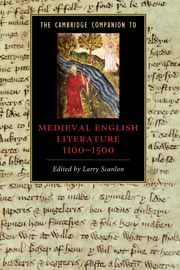17 - Sir Thomas Malory
from Part II - Authors
Published online by Cambridge University Press: 28 November 2009
Summary
Sir Thomas Malory's Morte Darthur evokes a Middle Ages of expiring time, a culture bequeathing one last literary testament as it fades from view. The sense of loss suggested by Malory's languorous prose, particularly that of his final Tale, resonates with many succeeding English generations. So too does the half-hope of Arthur's return from the dead, or from Avalon (p. 716), at the nation's hour of need; or that the imperial project of the Morte, achieved and then lost by the end of the text, might come again. Readings of Malory also accompany the long-sustained and ultimately frustrated project of carrying English aristocratic rule to the world. This begins with the naming of Henry VII's first-born son as Arthur. It continues in 1522 as Henry VIII, assuming his dead brother's mantle, escorts Charles V, Emperor-elect of the Romans, to a London pageant starring “the ryght noble and victorious emprowr Kynge Arthur with a crowne imperiall”; Charles is then led to Winchester to see, in the Round Table portrait, Arthur repainted in Henry's image and likeness. All this ends with the Somme and associated slaughters of the First World War: that massive loss of a chivalrically minded youth that, had they not stumbled into the age of barbed wire and machine guns, might have sustained English global imperium for a little while longer. Malory's Morte thus figures in England as a national epic with a dying fall: a text that might inspire even Milton to consider matters Arthurian before settling on the neo-biblical landscapes of Paradise Lost. And yet, simultaneously, the Morte is romance: a text that, foreknowing its inevitable end, opens spaces for play and diversion; for time off the teleological clock. Like the Canterbury Tales, the Morte anticipates the heavy curtain of repentance and death, social disintegration and final judgment. Yet, like the Tales, it keeps thought at bay through pleasurable dilation; through the art most brilliantly exemplified by Chaucer’s Wife of Bath, another teller of Arthurian tales, as “wandrynge by the weye.”
- Type
- Chapter
- Information
- The Cambridge Companion to Medieval English Literature 1100–1500 , pp. 229 - 242Publisher: Cambridge University PressPrint publication year: 2009

